Emergency Medicine > EXAM > Emergency Medical Technician; EMT-B Final Exam Test Bank Study Set Questions and Answers (All)
Emergency Medical Technician; EMT-B Final Exam Test Bank Study Set Questions and Answers_ 2022.
Document Content and Description Below
Emergency Medical Technician; EMT-B Final Exam Test Bank Study Set Questions and Answers_ 2022. (Sample) EMT-B Final Exam Study Set Questions and Answers_ Updated 2022. C. National Hi... ghway Transportation Safety Administration (NHTSA). - Most EMT training programs are based on standards developed by the: A. American Red Cross (ARC). B. American Heart Association (AHA). C. National Highway Transportation Safety Administration (NHTSA). D. National Institutes of Health (NIH). D. being pleasant, cooperative, and sincere, and a good listener. - An EMT can inspire patient confidence and cooperation by: A. transporting the patient from the scene to a hospital. B. providing patient care without regard for her own personal safety. C. telling the patient that everything will be all right. D. being pleasant, cooperative, and sincere, and a good listener. C. negligence. - If an on-duty EMT fails to provide the standard of care and if this failure causes harm or injury to the patient, the EMT may be accused of: A. assault. B. abandonment. C. negligence. D. breach of promise. D. informed - You are treating a conscious and mentally competent adult patient who wants to refuse your care and transport to the hospital. This refusal must be _____ and documented. A. implied B. actual C. involuntary D. informed B. implied - The EMT is authorized to treat and transport an unconscious patient because of the legal consideration known as _____ consent. A. applied B. implied C. triage D. immunity D. meaningless. - A child falls of a trampoline at an elementary school and twists her ankle. Because the parents are not present, the child's consent is A. not needed. B. actual. C. implied. D. meaningless. C. Good Samaritan laws - In some states, _____ help protect the off-duty EMT from lawsuits when stopping at the scene of a collision to offer assistance. A. professional associations B. blanket insurance policies C. Good Samaritan laws D. abandonment laws A. entering hazmat scenes with SCBA. - Each of the following is the responsiblity of an EMT at a hazardous-materials (hazmat) incident except: A. entering hazmat scenes with SCBA. B. protecting yourself and others. C. recognizing potential problems. D. notifying the hazardous-materials response team. B. Standard Precautions. - The form of infection control that assumes that all body fluids should be considered potentially infectious is: A. infectious disease. B. Standard Precautions. C. immunity. D. universal precautions. D. the distance the patient needs to be carried. - When planning to lift a patient, all of the following are important considerations for the EMT except: A. the weight of the patient. B. one's physical characteristics. C. communicating with one's partner. D. the distance the patient needs to be carried. C. use the leg muscles to do the lift. - When lifting an injured patient, the EMT should: A. keep the back loose and knees locked. B. twist or attempt to make moves other than the lift. C. use the leg muscles to do the lift. D. try not to talk to her or his partner. C. use a stair chair whenever possible. - You are treating a 45-year-old male who twisted his ankle in the upstairs bathroom. To carry this patient on the stairs, you should: A. keep the stretcher as level as possible. B. use a long backboard at all times. C. use a stair chair whenever possible. D. do all of these. C. keep arms straight when pulling. - Ways an EMT can avoid a potential back injury include all of the following except: A. push, rather than pull, a load. B. keep the back locked in while lifting. C. keep arms straight when pulling. D. push or pull from a kneeling position if the weight is below waist level. D. the patient is unconscious. - An emergency move is required in each of the following situations except when: A. the scene is hazardous. B. care of life-threatening conditions requires repositioning. C. other patients who have life threats must be reached. D. the patient is unconscious. A. A spinal injury may be aggravated. - Which of the following is the greatest danger to the patient in an emergency move? A. A spinal injury may be aggravated. B. Bleeding may increase after movement. C. The airway may become obstructed. D. There is no danger associated with an emergency move. B. extremity lift. - A method of lifting and carrying a patient in which one EMT slips hands under the patient's armpits and grasps the wrists while another EMT grasps the patient's knees is called the: A. direct ground lift. B. extremity lift. C. draw-sheet method. D. direct carry method. B. modified draw-sheet method. - Your patient is a medical patient with a suspected drug overdose. He is lying supine on your stretcher, and you have been maintaining his airway. When moving him from the ambulance stretcher to the hospital stretcher, you will probably use the: A. crade carry. B. modified draw-sheet method. C. direct ground lift. D. extremity lift. A. opposite sides - To load the wheeled ambulance stretcher into the ambulance, the two EMTs should position themselves on _____ of the stretcher. A. opposite sides B. opposide ends C. the same side D. one end and one side B. extremity lift. - You are treating a 28-year-old conscious diabetic who has an altered level of consciousness. She is lying on the floor at the moment. To move her from the floor to a stair chair, use the: A. indirect carry. B. extremity lift. C. slide transfer. D. chair lift. A. do not protect the patient's neck and spine. - Drags are used only in emergencies because they: A. do not protect the patient's neck and spine. B. require excessive energy from the EMT. C. may injure the EMT's back. D. provide full immobilization. B. an even number of - To maintain balance when lifting a patient-carrying device, it is best to use _____ rescuers to carry the device. A. three B. an even number of C. an odd number of D. bystanders and B. make an urgent move. - You are treating the driver of a vehicle involved in a collision. He is a 22-year-old male who requires immediate airway and bleeding control. You are unable to provide this treatment in the vehicle. You should: A. check the patient's vital signs. B. make an urgent move. C. remove the patient on a short backboard. D. do all of these. D. Piggyback - Your patient is an unconscious adult female stroke patient. Which carry is considered very difficult to use with an unconscious person? A. Cradle B. Three-rescuer C. Shoulder D. Piggyback C. firefighter's - The _____ carry must be performed in one unbroken sweep. A. pack strap B. front piggyback C. firefighter's D. four-rescue C. flexible - A canvas or rubberized stretcher that can be used to move a patient through a narrow hallway or restricted are is called a _____ stretcher. A. basket B. portable C. flexible D. wheeled-ambulance B. clothes drag. - A patient with obvious spinal injuries is found on the floor of a burning building. The EMT rates the situation hazardous but not yet dire. Alone and without special equipment, the EMT should use the: A. cradle carry. B. clothes drag. C. firefighter's carry. D. pack-strap method. C. wheeled ambulance - The patient-carrying device of choice for the 20-year-old male who is dizzy by not injured is the _____ stretcher. A. portable ambulance B. wire basket C. wheeled ambulance D. slat D. All of these are reasons to serve as an advocate. - If you are an EMT with a service that does not provide the appropriate personal protective equipment, why should you serve as an advocate for this equipment? A. Your crew members could be injured unneccessarily. B. You could be seriously injured. C. An injured EMT is of little help to the patient. D. All of these are reasons to serve as an advocate. A. retreat to a safe area. - During an EMT call, a lethal threat is made by the 24-year-old intoxicated male. The EMT should first: A. retreat to a safe area. B. radio for assistance. C. reevaluate the situation. D. remedy the situation. B. Eustress - Of the different types of stress, which is a positive form that helps the EMT work under pressure and respond effectively? A. Eumulative stress B. Eustress C. Distress D. Critical incident stress C. enter the neighborhood. - When responding to a violent situation, observation beings when you: A. enter the scene. B. exit the ambulance. C. enter the neighborhood. D. arrive at the patient's side. B. carry a portable radio. - To ensure crew safety, one member of the crew should always: A. remain in the ambulance. B. carry a portable radio. C. wear a bulletproof vest. D. carry a canister of pepper gas. B. quickly control the bleeding; then have the dog locked in another room. - While you are treating a patient with a severely bleeding forearm, the patient's pet dog appears. The patient states, "He won't hurt you. He's very friendly." Your best course of action would be to: A. have your partner observe the dog closely while you treat the patient. B. quickly control the bleeding; then have the dog locked in another room. C. ignore the dog because the patient assures you it is friendly and will not harm you. D. do all of these. C. treat life-threatening problems and transport. - If a patient refuses care and then becomes unconscious, it is best for the EMT to: A. refuse to treat or transport the patient. B. ask a family member for permission to treat. C. treat life-threatening problems and transport. D. contact medical direction for advice. B. the patient's expressed wishes may be followed. - An advantage of the advance directive is that: A. the patient is not involved in making a secision about her treatment. B. the patient's expressed wishes may be followed. C. no matter what the family says, CPR is not given. D. it protects the EMT from charges of negligence. C. not a reason to withhold medical care. - In most cases, the oral wishes of the patient's family to withhold care are: A. all that is needed to stop CPR from being initiated. B. all that is needed to stop CPR once it is initiated. C. not a reason to withhold medical care. D. not sufficient unless they are given in writing. D. do all of these. - Some EMTs participate in activities that attract legal actions, while most EMTs are rarely involved in legal entanglements. You can prevent most lawsuits if you: A. provide care within the scope of your practice. B. properly document your care. C. are courteous and respectful to all your patients. D. do all of these. D. health insurance costs. - The negligent EMT may be required to pay for all of the following except the patient's: A. lost wages. B. medical expenses. C. pain and suffering D. health insurance costs. D. It regulates body temperature. - Which of the following is not a function of the musculoskeletal system? A. It gives the body shape. B. It protects the internal organs. C. It provides for body movement. D. It regulates body temperature. C. manubrium. - The superior portion of the sternum is called the: A. xiphoid process. B. sternal body. C. manubrium. D. clavicle. B. medial malleolus. - A young girl fell while ice skating and injured the protrusion on the inside of the ankle. The medical term for this location is the: A. acromion. B. medial malleolus. C. lateral malleolus. D. calcaneus. B. automaticity - The heart muscle has property called _____. This means that the heart has the ability to generate and conduct electrical impulses on its own. A. contractibility B. automaticity C. involuntary contraction D. conductibility A. autonomic - A division of the peripheral nervous system that controls involuntary motor functions is called the _____ nervous system. A. autonomic B. central C. sensory D. motor B. the observer. - When in the anatomical position, a person is facing: A. away from you. B. the observer. C. face down. D. face up. A. forward. - In the anatomical position, the person's palms will be facing: A. forward. B. backward. C. upward. D. downward. D. plantar. - An anatomical term that is occasionally used to refer to the sole of the foot is: A. calcaneus. B. ventral. C. dorsal. D. plantar. C. zygomatic - The bones of the cheek are called the _____ bones. A. orbit B. maxillae C. zygomatic D. mandible D. superior - The heart is _____ to the stomach. A. distal B. medial C. proximal D. superior B. proximal; distal - When comparing body structure positions, the knees are said to be _____ to the toes, and the toes are _____ to the knees. A. inferior; superior B. proximal; distal C. distal; dorsal D. anterior; posterior C. supine - A patient found lying on her back is in the _____ position. A. anatomical B. prone C. supine D. lateral recumbent C. four - To assist in describing the location of abdominal organs, we divide the abdomen into _____ parts. A. two B. three C. four D. five A. thorax. - Your 18-year-old male patient has severe burns of the entire front (anterior) surface of the torso. The torso of the body is composed of the abdomen, pelvis, and: A. thorax. B. upper arms and legs. C. extremities. D. head. A. thoracic - The heart is located in the center of the _____ cavity. A. thoracic B. cranial C. pelvic D. cardiac C. diaphragm. - The structure that divides the chest cavity from the abdominal cavity is the: A. meninges. B. duodenum. C. diaphragm. D. spinal column. C. patella. - The anatomical name for the kneecap is the: A. ilium. B. malleolus. C. patella. D. phalange. C. top, back, and sides of the skull. - The cranium consists of the: A. facial bones. B. mandible and maxillae. C. top, back, and sides of the skull. D. zygomatic bones. A. acromion process. - The highest point in the shoulder is the: A. acromion process. B. humerus. C. metatarsal. D. clavicle. C. Good Samaritan - At the scene of a collision, an off-duty EMT provides care to the patient, acting in good faith and to the best of her abilities. In many states, this EMT is protected from care-related lawsuits by _____ laws. A. applied consent B. total immunity C. Good Samaritan D. jeopardy B. consider consent for care to be implied and begin care. - When confronted with an unconscious minor without parents or a legal guardian present, the EMT should: A. seek a physician's approval before beginning care. B. consider consent for care to be implied and begin care. C. ask the child for consent and begin care. D. consider consent to be applied and begin care. C. The EMT had a local duty. - The legal concept of negligence requires that three circumstances must me demonstrated. Which of the following is not one of the three circumstances? A. The EMT had a duty to act. B. The EMT committed a breach of duty. C. The EMT had a local duty. D. The breach of duty caused harm. B. prone - A person lying on his stomach with his face down is in the _____ position. A. supine B. prone C. coma D. recovery C. denial, anger, bargaining, depression, acceptance. - As an EMT, you have been assigned to take a terminally ill patient back and forth to chemotherapy multiple times a week for the next few weeks. You realize that the patient has been going through emotional stages in the following order: A. depression, bargaining, denial, acceptance, anger. B. acceptance, rage, depression, acceptance, bargaining. C. denial, anger, bargaining, depression, acceptance. D. bargaining, acceptance, denial, anger, depression. B. National Registry of Emergency Medical Technicians - In 1970, the _____ was founded to establish professional standards for EMS personnel. A. American Medical Association B. National Registry of Emergency Medical Technicians C. National Highway Traffic Safety Administration D. U.S. Department of Transportation D. ambulance. - Safe, reliable transportation is a critical component of an EMS system. Most patients can be transported effectively by: A. airplane. B. helicopter. C. rescue vehicle. D. ambulance. B. EMT-Intermediate - An _____ is a national-level EMT who has been trained to start IVs, perform advanced airway techniques, and administer some medicines beyond the EMT. A. EMT-First Responder B. EMT-Intermediate C. EMT-Critical Care D. EMT-Paramedic B. quality improvement. - A continuous self-review with the purpose of identifying and correcting aspects of the EMS system that require improvement is called: A. standing orders. B. quality improvement. C. protocols. D. medical direction. B. Medical Director. - A physician who assumes the ultimate responsibility for the patient-care aspects of the EMS system is called the: A. Designated Agent. B. Medical Director. C. Off-line Director. D. Primary Care Physician. A. patients who refuse care. - Situations that are higher risks of a lawsuit against an EMS agency are: A. patients who refuse care. B. on-scene deaths. C. cardiac arrest cases. D. pedestrians struck by cars. D. scope of practice. - The legal extent or limits of the EMT's job are formally defined by the: A. patient. B. DOT curriculum. C. state. D. scope of practice. A. Decisiveness - Which is not generally considered a sign or symptom of stress? A. Decisiveness B. Guilt C. Loss of interest in work D. Difficulty sleeping D. motor vehicle collisions. - All of the following are types of calls that have a high potential for causing excessive stress except: A. calls involving infants and children. B. patients with severe injuries. C. cases of abuse and neglect. D. motor vehicle collisions. B. increased consumption of fatty foods. - Lifestyle changes that can help the EMT deal with stress include all of the following except: A. exercise to burn off tension. B. increased consumption of fatty foods. C. decreased consumption of caffeine. D. decreased consumption of alcohol. A. requesting a change of shift or location. - Changes in your professional life to reduce and prevent stress can include: A. requesting a change of shift or location. B. taking on another part-time position. C. working additional overtime shifts. D. requesting a busier location. D. protect the body from the environment, bacteria, and other organisms. - One of the functions of the integumentary system is to: A. regulate the diameter of the blood vessels in the circulation. B. eliminate excess oxygen into the atmosphere. C. allow environmental water to carefully enter the body. D. protect the body from the environment, bacteria, and other organisms. C. normal and to be expected. - Stress after a major EMS incident is: A. unusual and expected. B. a sign of weakness. C. normal and to be expected. D. part of the grieving process. B. depression. - Retreating to a world of one's own after hearing one is going to die is a result of the stage of grief called: A. bargaining. B. depression. C. denial. D. anxiety. B. anaerobic metabolism. - When a patient's lower extremities are trapped under a farm tractor, the blood supply is diminished to the cells in the legs. This injury can result in: A. no lactic acids being produced. B. anaerobic metabolism. C. no carbon dioxide being produced. D. none of these. C. bloodborne - A disease that is spread by exposure to an open wound or sore of an infected individual is caused by a(n) _____ pathogen. A. universal B. airborne C. bloodborne D. infectious D. hepatits. - An infection that causes inflammation of the liver is called: A. meningitis. B. tuberculosis. C. typhoid. D. hepatitis. C. airborne. - A disease spread by inhaling or absorbing droplets from the air through the eyes, nose, or mouth is considered: A. bloodborne. B. noncommunicable. C. airborne. D. viral. D. hepatitis B virus. - The communicable disease that kills the most health workers every year in the United States is: A. tuberculosis. B. HIV/AIDS. C. meningitis. D. hepatitis B virus. B. productive cough has TB. - Always assume that any patient with a: A. cold has a bloodborne disease. B. productive cough has TB. C. fever has typhoid. D. rash has measles. D. It is an airborne pathogen. - Which of the following is not true about the human immunodeficiency virus (HIV)? A. It attacks the immune system. B. It doesn't survive well outside the human body. C. It can be introduced through puncture wounds. D. It is an airborne pathogen. C. 30 percent. - Your patient has hepatitis B. You are accidentally stuck with a needle that has some of this patient's infected blood on it. Your chance of contracting the disease is about: A. 10 percent. B. 20 percent. C. 30 percent. D. 40 percent. A. 0.5 percent. - Your patient has HIV. You are accidentally stuck with a needle that has some infected blood on it. Your chance of contracting the disease is about: A. 0.5 percent. B. 5 percent. C. 10 percent. D. 15 percent. C. HEPA or N-95 respirator. - If you think your patient has TB, you should wear the usual personal protective equipment plus a: A. surgeon's mask. B. gown. C. HEPA or N-95 respirator. D. Tyvek suit. A. pocket mask with a one-way valve. - Instead of providing mouth-to-mouth ventilations on the nonbreathing patient, the EMT, when acting alone, should use a(n): A. pocket mask with a one-way valve. B. one-way valve. C. bag-valve mask. D. endotracheal tube. C. Hand washing after each patient contact - Which method of infection control reduces exposure to yourself, your crew, and your next patient? A. Wearing a HEPA or N-95 respirator B. Taking universal precautions C. Hand washing after each patient contact D. None of these B. the Ryan White CARE Act. - An act that establishes procedures through which emergency response workers can find out if they have been exposed to life-threatening infectious diseases is called: A. OSHA 1910.1030. B. the Ryan White CARE Act. C. AIDS Protection Act. D. OSHA 1910.120. A. OSHA 1910.1030. - Each emergency response employer must develop a plan that identifies and documents job classifications and tasks in which there is the possibility for expoure to potentially infectious body fluids. This is required by: A. OSHA 1910.1030. B. the Ryan White CARE Act. C. the AIDS Protection Act. D. OSHA 1910.120. D. hepatitis B vaccination. - Every employer of EMTs must provide free of charge: A. a yearly physical examination. B. a life insurance policy. C. universal health insurance. D. hepatitis B vaccination. D. all of these. - Engineering controls that prevent the spread of bloodborne diseases include: A. pocket masks. B. needle containers. C. disposable airway equipment. D. all of these. C. HEPA or N-95 respirator - Which of the following is not required by the OSHA bloodborne pathogen standard? A. Postexposure evaluation and follow-up B. Personal protective equipment C. HEPA or N-95 respirator D. Housekeeping controls and labeling B. Daycare centers - Which of the following is not considered a high-risk area for TB? A. Correctional facilities B. Daycare centers C. Homeless shelters D. Nursing homes D. turn off your lights and siren. - As you near an emergency scene, you should: A. sound your siren to broadcast your arrival. B. go straight to the front door. C. secure the scene as quickly as possible. D. turn off your lights and siren. A. notify the police immediately. - If anyone at the scene is in possession of a weapon, the EMT should: A. notify the police immediately. B. ask the person to give it to you. C. ignore the person with the weapon. D. advise the person to leave the scene. A. respiratory failure. - The reduction of breathing to the point where oxygen intake is not sufficient to support life is called: A. respiratory failure. B. anoxic metabolism. C. respiratory arrest. D. respiratory support. C. blue or gray skin coloration. - Adequate signs of breathing include all of the following except: A. equal expansion of both sides of the chest. B. air moving in and out of the nose. C. blue or gray skin coloration. D. present and equal breath sounds. B. nasal flaring. - The widening of the nostrils of the nose with respirations is called: A. hyperventilating. B. nasal flaring. C. nasal gurgling. D. wheezing. B. cyanosis. - The condition in which a patient's skin or lips are blue or gray is called: A. stridor. B. cyanosis. C. pallor. D. anemia. C. shortness of breath. - If a patient is unable to speak in full sentences, this could be a sign of: A. complete airway blockage. B. snoring. C. shortness of breath. D. respiratory arrest. B. inserting an endotracheal tube immediately. - The procedures by which life-threatening respiratory problems are initially treated by the EMT include all of the following except: A. opening and maintaining the airway. B. inserting an endotracheal tube immediately. C. providing supplemental oxygen to the breathing patient. D. ensuring a clear airway with frequent suctioning. A. the tongue. - You are assessing the airway of an unconscious male patient. You recall that most airway problems are caused by: A. the tongue. B. asthma. C. shock. D. the epiglottis. D. Jaw-thrust - You are treating a patient who fell down a flight of metal stairs. Which maneuver is most appropriate for an unconscious patient found lying at the bottom of a stairwell? A. Head-tilt, chin-lift B. Head-tilt, neck-lift C. Jaw-pull lift D. Jaw-thrust B. one-rescuer bag-valve mask. - You are managing a 34-year-old male who you suspect has had a narcotic overdose. His respirations are very slow and shallow, and you will need to assist them. When choosing a means of ventilating a patient, your last choice would be: A. flow-restricted, oxygen-powered ventilation device. B. one-rescuer bag-valve mask. C. two-rescuer bag-valve mask. D. mouth-to-mask with high-flow supplemental oxygen. C. rate of ventilation is too fast or too slow. - Artificial ventilation may be inadequate if the: A. chest rises with each ventilation. B. heart rate returns to normal. C. rate of ventilation is too fast or too slow. D. skin becomes warm and dry. A. 15/22 mm. - The standard respiratory fitting on a bag-valve mask that ensures a proper fit with other respiratory equipment is: A. 15/22 mm. B. 10/14 mm. C. 5/20 mm. D. 20/26 mm. D. a pop-off valve. - A bag-valve mask should have or be all of the following except: A. a self-refilling shell. B. a clear face mask. C. easily cleared and sterilized. D. a pop-off valve. C. 15 - The proper oxygen flow rate when ventilating a patient with a BVM is _____ liters per minute. A. 5 B. 10 C. 15 D. 20 B. sufficient to achieve visible chest rise. - According to the American Heart Association guidelines, when ventilating a patient with a bag mask that has supplementary oxygen, the volume administered should be: A. 400 milliliters. B. sufficient to achieve visible chest rise. C. 800 milliliters. D. as much as possible during the 1-second time frame. C. clear any mucus or secretions obstructing the stoma. - The first step in providing artificial ventilation of a stoma breather is to: A. leave the head and neck in a neutral position. B. ventilate at the appropriate rate for the patient's age. C. clear any mucus or secretions obstructing the stoma. D. establish a seal using a pediatric-sized mask. A. an audible alarm when ventilation is activated. - A flow-restricted, oxygen-powered ventilation device should have all of the following features except: A. an audible alarm when ventilation is activated. B. a trigger that enables the rescuer to use both hands. C. a peak flow rate of up to 40 liters per minute. D. a rugged design and construction. B. nasopharyngeal airway. - The two most common airway adjuncts for the EMT to use are the oropharyngeal airway and the: A. nasal cannula. B. nasopharyngeal airway. C. endotracheal tube. D. Yankauer. D. all unconscious patients with no gag reflex. - An oropharyngeal airway should be inserted in: A. all patients with inadequate breathing. B. trauma patients with a gag reflex. C. medical patients with a gag reflex. D. all unconscious patients with no gag reflex. C. never suction for longer than 15 seconds. - When suctioning a 19-year-old patient who you suspect has bleeding into his throat, you should: A. suction on the way in and the way out. B. avoid using eyewear or a mask. C. never suction for longer than 15 seconds. D. hypoventilate prior to suctioning. C. shock. - The emergency situation in which there is a failure of the cardiovascular system to provide sufficient blood to all the vital tissues is called: A. respiratory arrest. B. respiratory failure. [Show More]
Last updated: 1 year ago
Preview 1 out of 124 pages
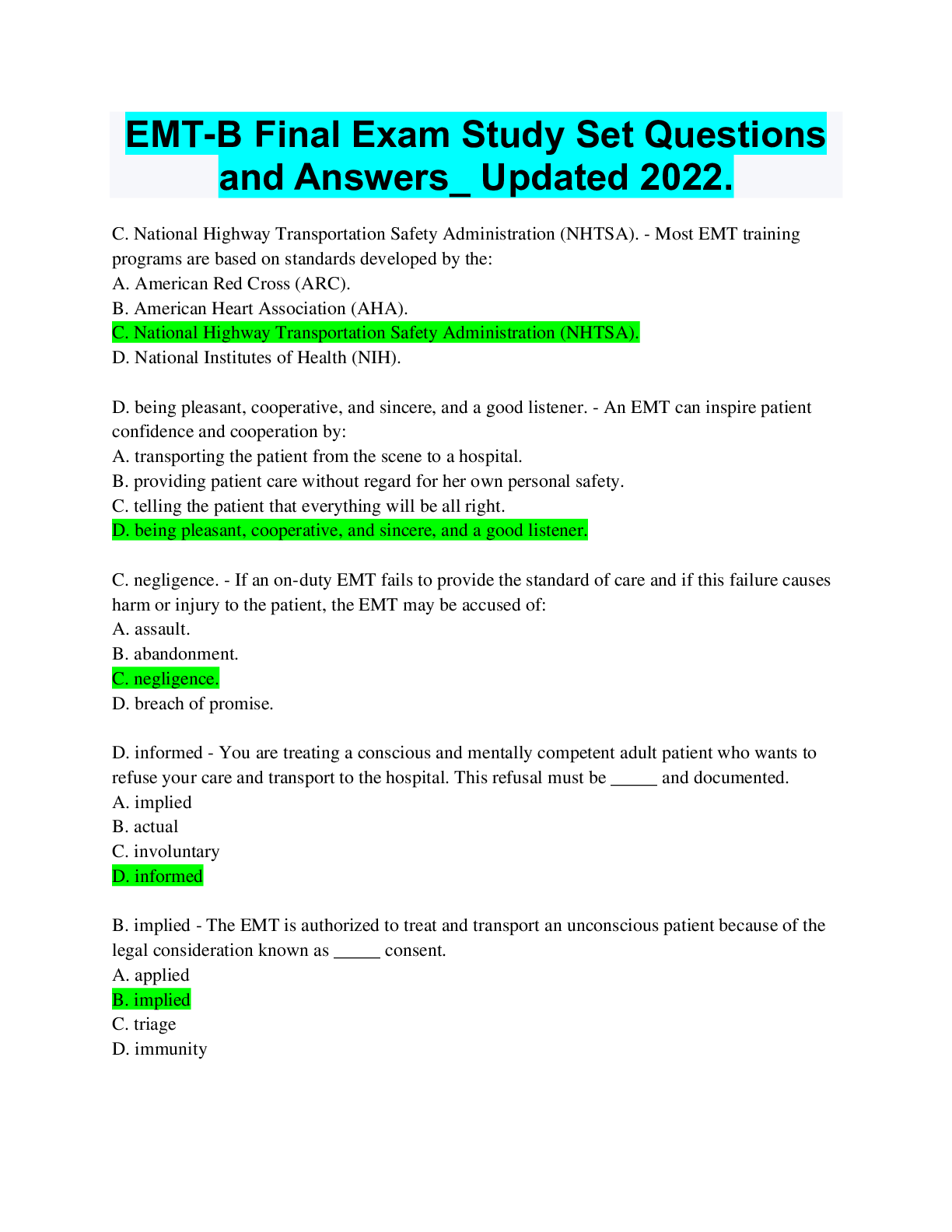
Reviews( 0 )
Recommended For You
ATI MED SURG PROCTORED> EXAM > Med Surg ATI Proctored Exam Test Bank 2023/2024 With NGN (All)

Med Surg ATI Proctored Exam Test Bank 2023/2024 With NGN
Med Surg ATI Proctored Exam Test Bank 2023/2024 With NGN Med Surg ATI Proctored Exam Test Bank 2023/2024 With NGN Med Surg ATI Proctored Exam Test Bank 2023/2024 With NGN Med Surg ATI Proctored E...
By EXAMHUB SOLUTIONS , Uploaded: Apr 15, 2024
$30.5
*NURSING> EXAM > HESI Exit Exam Test Bank Latest Version 2022. (All)
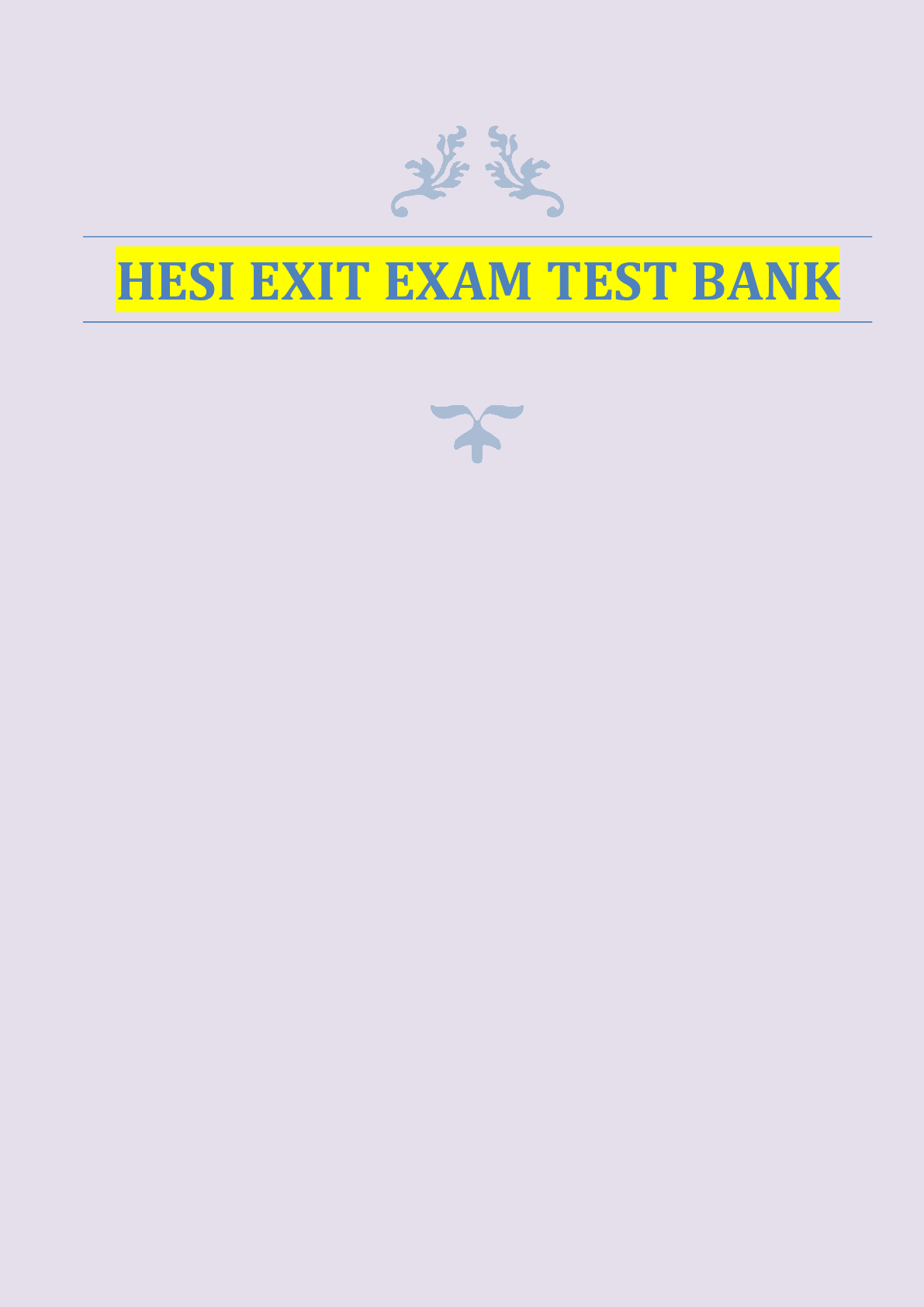
HESI Exit Exam Test Bank Latest Version 2022.
HESI Exit Exam Test Bank Latest Version 2022.1. Following discShtuavirag.ceomt-eTahechMianrkget,plaacemtoaBluey acnldieSnelltyowuritShtuddyuMoadteerianl al ulcer tells the nurse the he will drink p...
By Rixx Dennis , Uploaded: Feb 02, 2022
$20.5
NCLEX RN> EXAM > NCLEX RN ACTUAL EXAM TEST BANK OF REAL QUESTIONS & ANSWERS NCLEX 2023 (All)
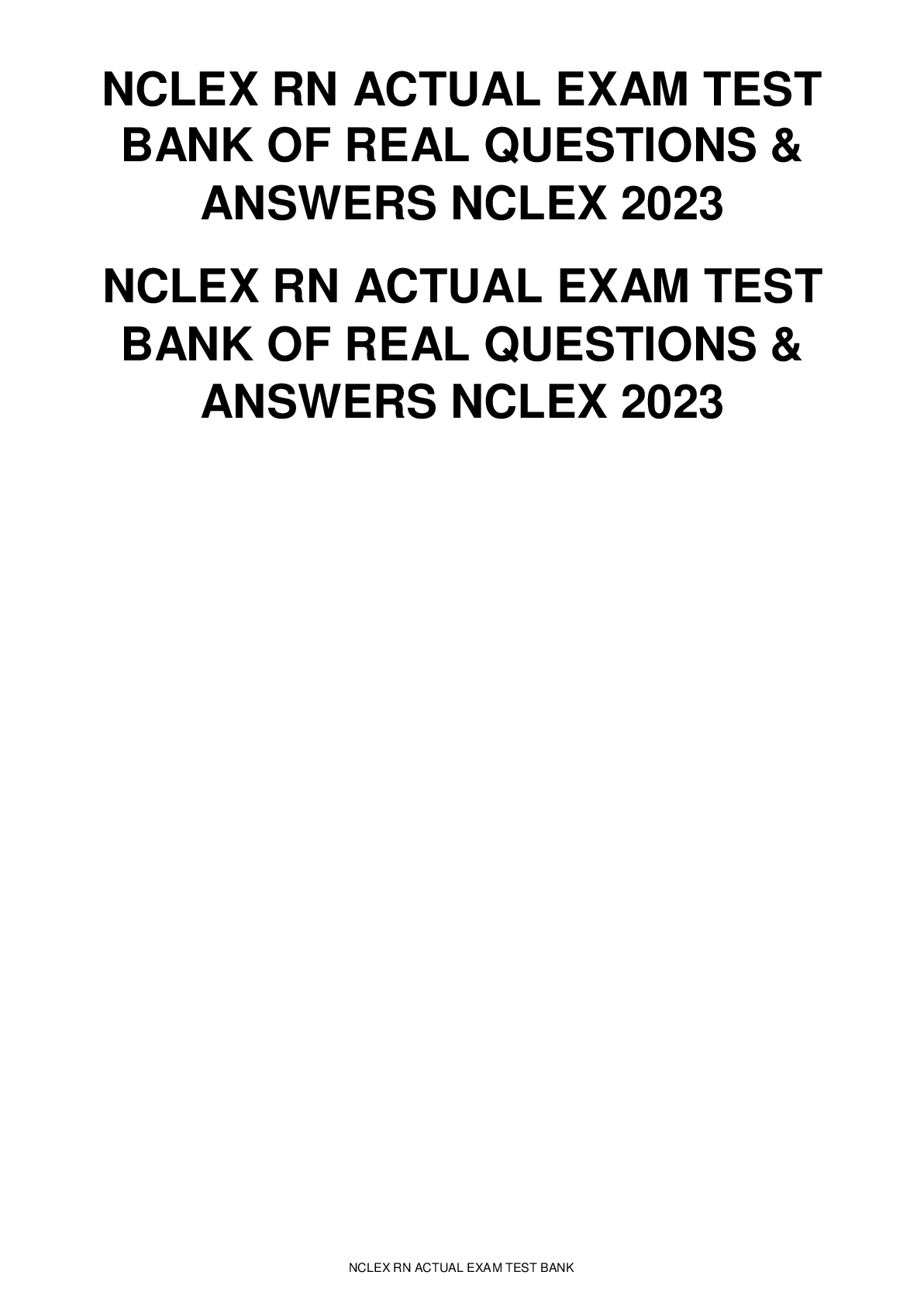
NCLEX RN ACTUAL EXAM TEST BANK OF REAL QUESTIONS & ANSWERS NCLEX 2023
QUESTION 1 Which classification of drugs is contraindicated for the client with hypertrophic cardiomyopathy? A. Positive inotropes B. Vasodilators C. Diuretics D. Antidysrhythmics Answer: A...
By TopRankProf , Uploaded: Jun 01, 2023
$25
HESI A2 ENTRANCE> EXAM > HESI A2 EXAM TEST BANK Nursing Admission Entrance EXAM (All)
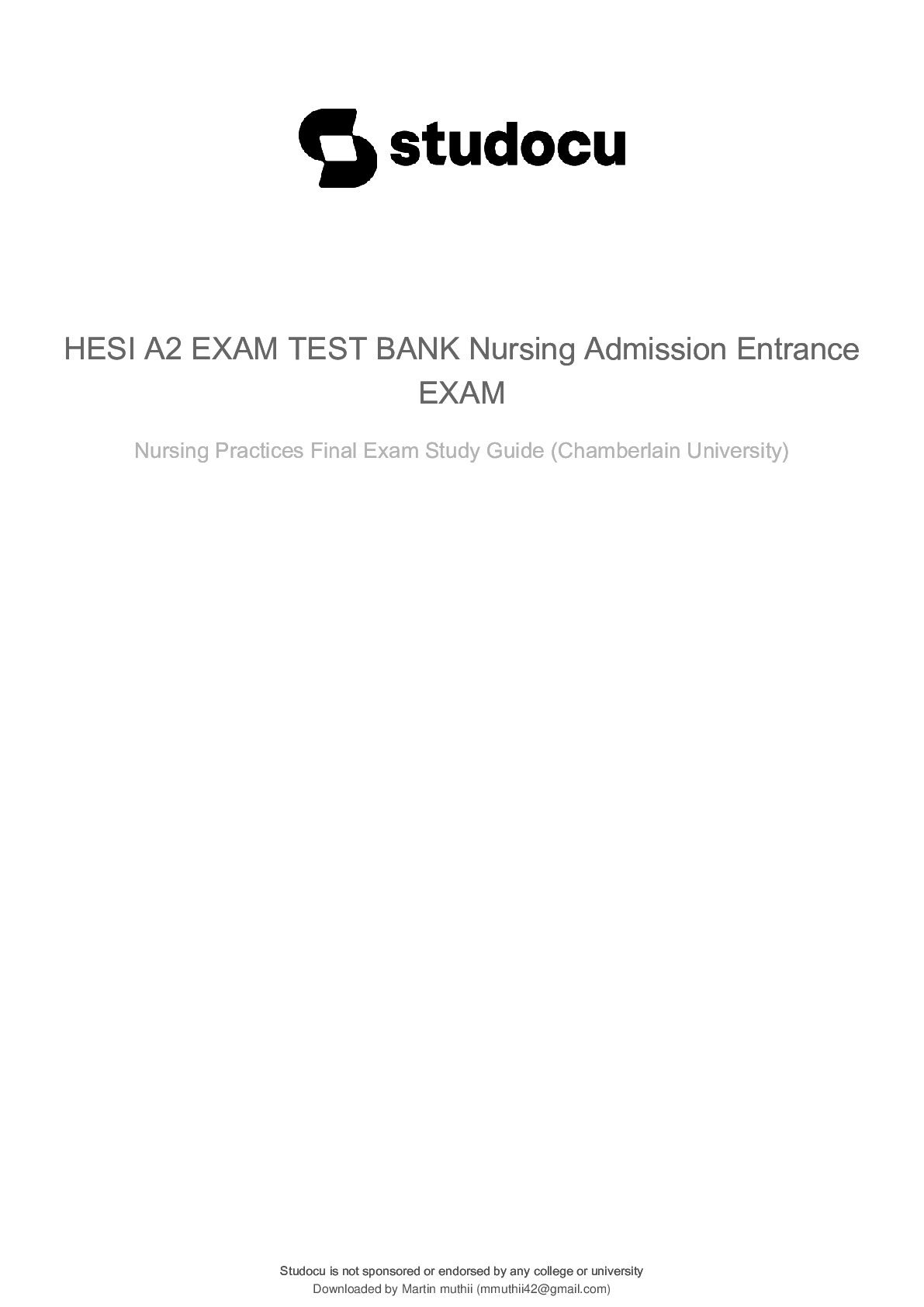
HESI A2 EXAM TEST BANK Nursing Admission Entrance EXAM
HESI A2 EXAM TEST BANK Nursing Admission Entrance EXAM
By Splashnet42 , Uploaded: Jun 02, 2023
$24
*NURSING> EXAM > NSG 5003 - PATHOPHYSIOLOGY : EXAM TEST BANK (new guide) Questions + Correct Answers + References (All)
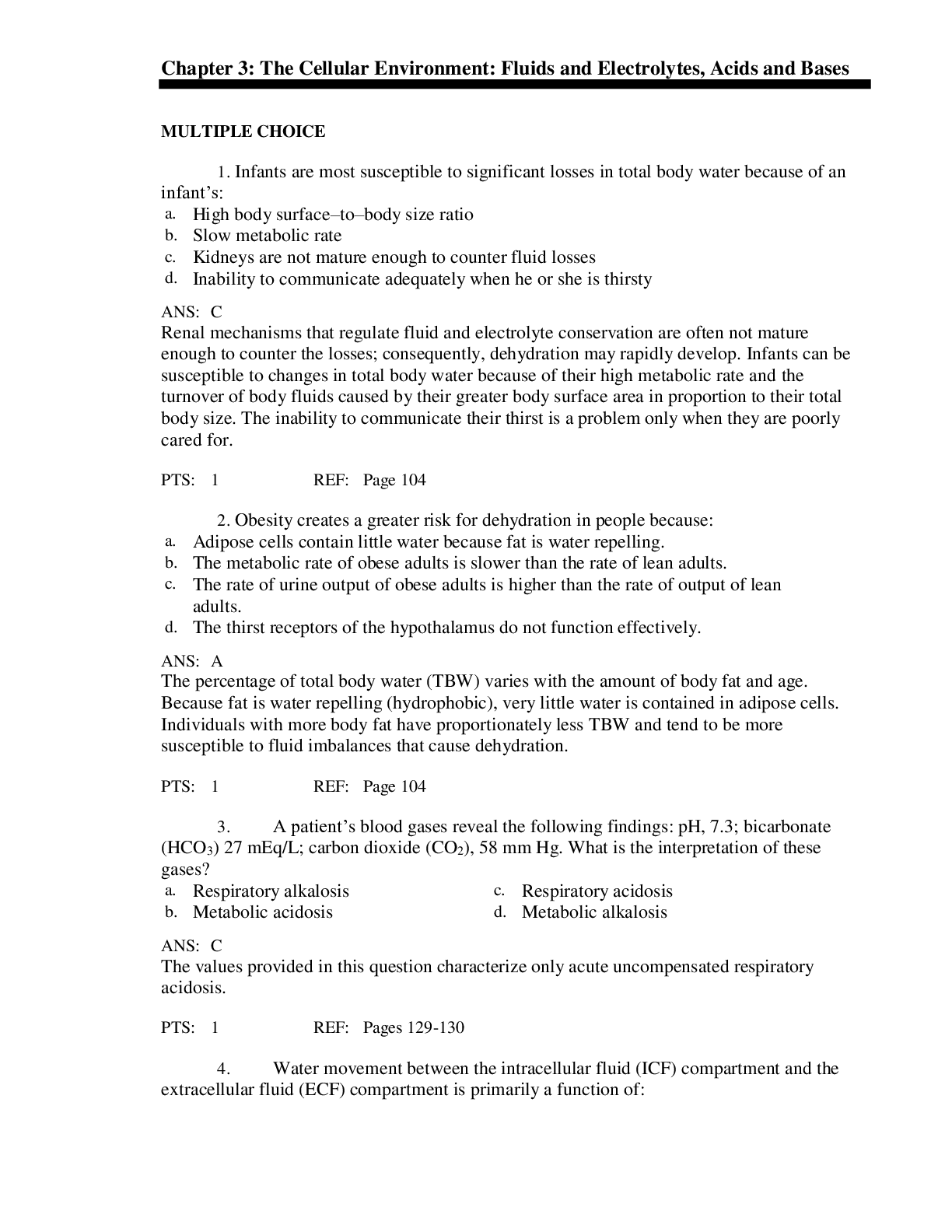
NSG 5003 - PATHOPHYSIOLOGY : EXAM TEST BANK (new guide) Questions + Correct Answers + References
PATHOPHYSIOLOGY MULTIPLE CHOICE MULTIPLE RESPONSE MATCHING Chapter 3: The Cellular Environment: Fluids and Electrolytes, Acids and Bases Chapter 34: Structure and Function of the Pulmonary Syst...
By Expert1 , Uploaded: Oct 18, 2019
$9.5
*NURSING> EXAM > ATI Pharmacology Proctored Exam Test Bank. CONTAINS OVER 350 Q&A plus RATIONALE (All)
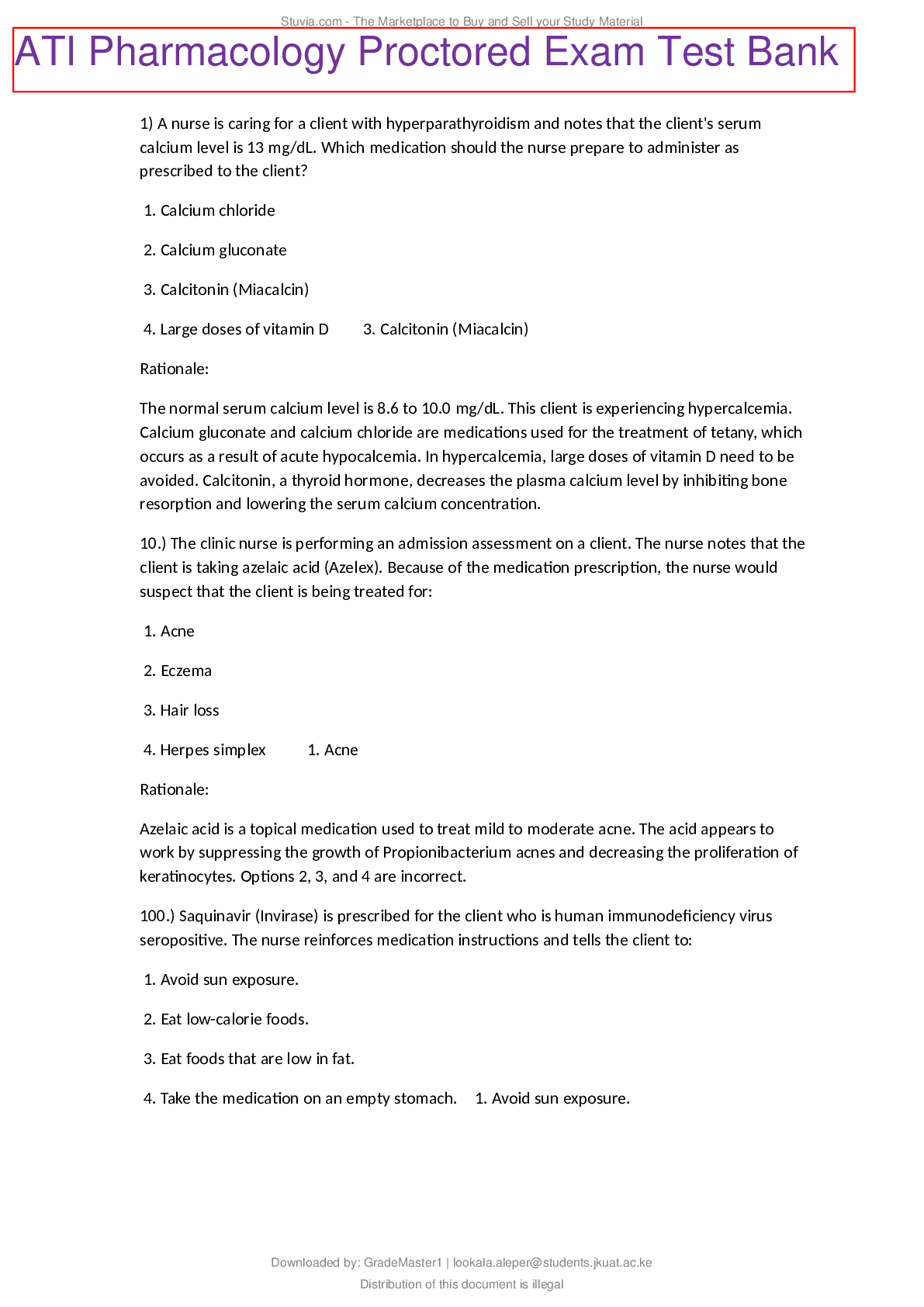
ATI Pharmacology Proctored Exam Test Bank. CONTAINS OVER 350 Q&A plus RATIONALE
ATI Pharmacology Proctored Exam Test Bank. CONTAINS OVER 350 Q7A plus RATIONALE 1) A nurse is caring for a client with hyperparathyroidism and notes that the client's serum calcium level is 13 mg/dL....
By TESTBANKS , Uploaded: Oct 14, 2021
$8
*NURSING> EXAM > NCLEX RN ACTUAL EXAM TEST BANK OF REAL QUESTIONS & ANSWERS NCLEX 2019 | NCLEX Exam (All)
NCLEX RN ACTUAL EXAM TEST BANK OF REAL QUESTIONS & ANSWERS NCLEX 2019 | NCLEX Exam
NCLEX RN ACTUAL EXAM TEST BANK OF REAL QUESTIONS & ANSWERS NCLEX 2019 | NCLEX Exam-Which classification of drugs is contraindicated for the client with hypertrophic cardiomyopathy? A. Positive inot...
By PROF , Uploaded: Sep 04, 2021
$27.5
*NURSING> EXAM > NSG 6020 MIDTERM EXAM TEST BANK; 100% VERIFIED Q&A; SOUTH UNIVERSITY (All)
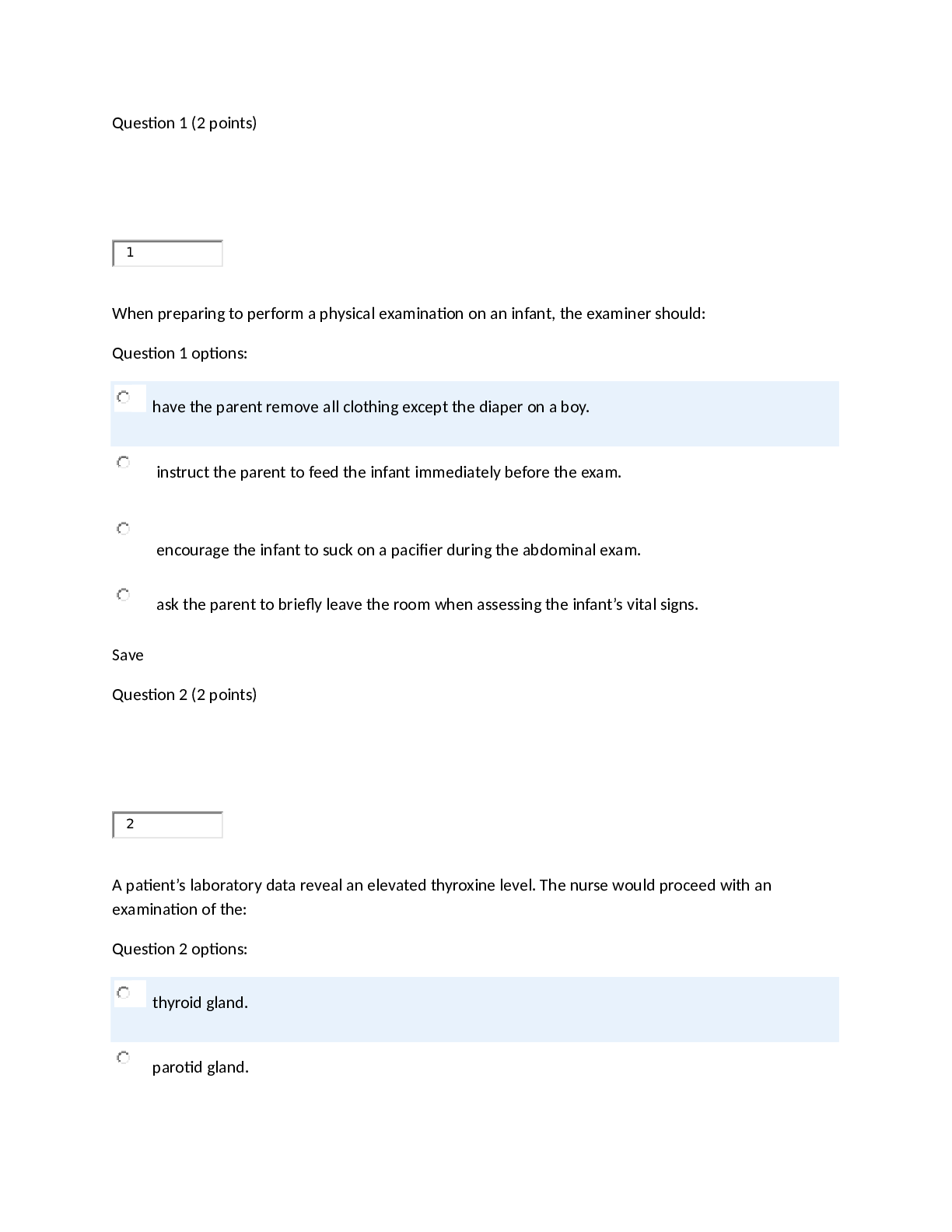
NSG 6020 MIDTERM EXAM TEST BANK; 100% VERIFIED Q&A; SOUTH UNIVERSITY
Question 1 (2 points) When preparing to perform a physical examination on an infant, the examiner should: Question 1 options: have the parent remove all clothing except the diaper on a boy. instru...
By BROWSEGRADE STUDIES , Uploaded: Aug 12, 2022
$11
*NURSING> EXAM > HESI PN EXIT EXAM TEST BANK 2020/2021 V1|Latest Version, Graded A+ (All)
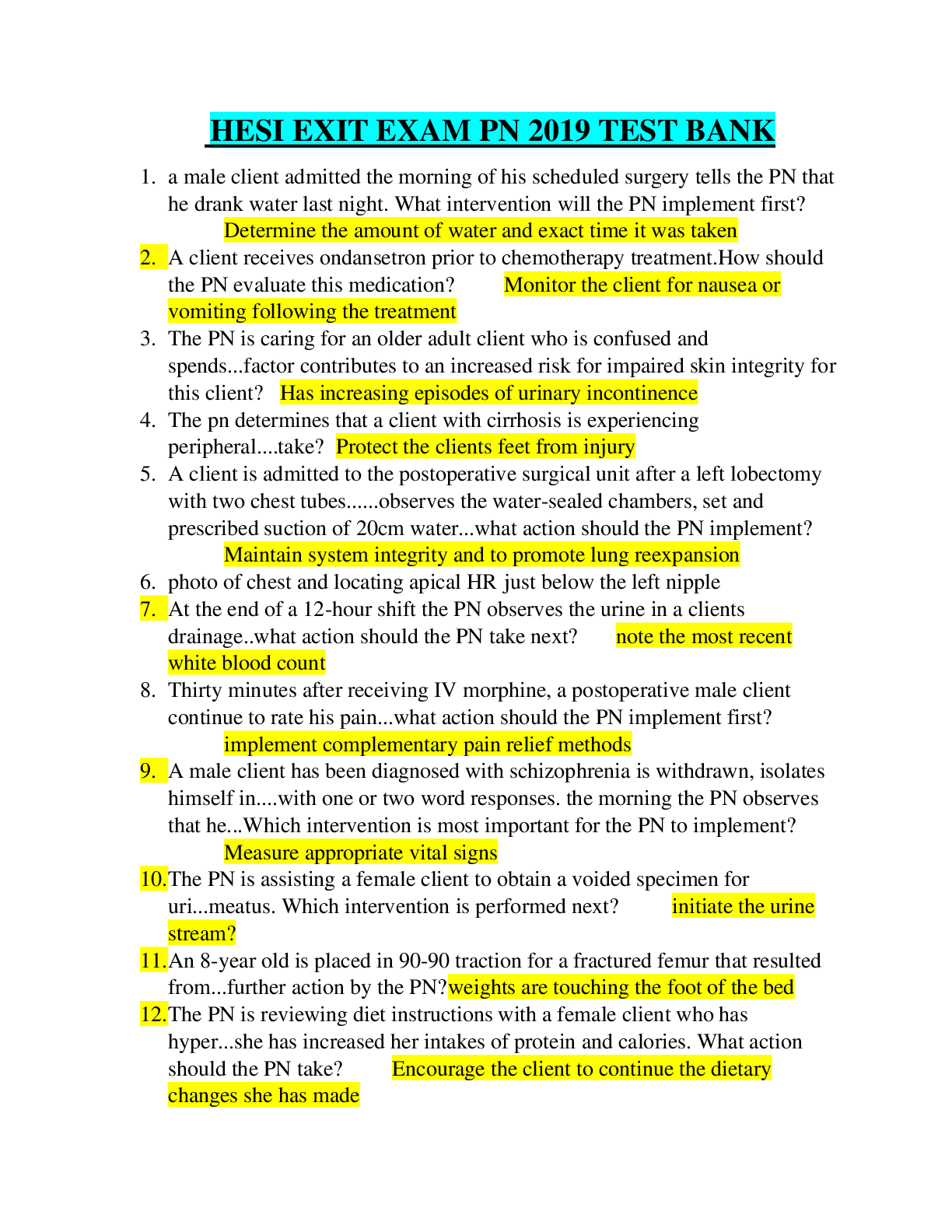
HESI PN EXIT EXAM TEST BANK 2020/2021 V1|Latest Version, Graded A+
HESI EXIT EXAM PN 2019 TEST BANK 1. A male client admitted the morning of his scheduled surgery tells the PN that he drank water last night. What intervention will the PN implement first? 2. A clie nt...
By PROF , Uploaded: Feb 25, 2021
$12
*NURSING> EXAM > HESI PN EXIT EXAM TEST BANK 2020/2021 V1|Latest Version, Graded A+ (All)
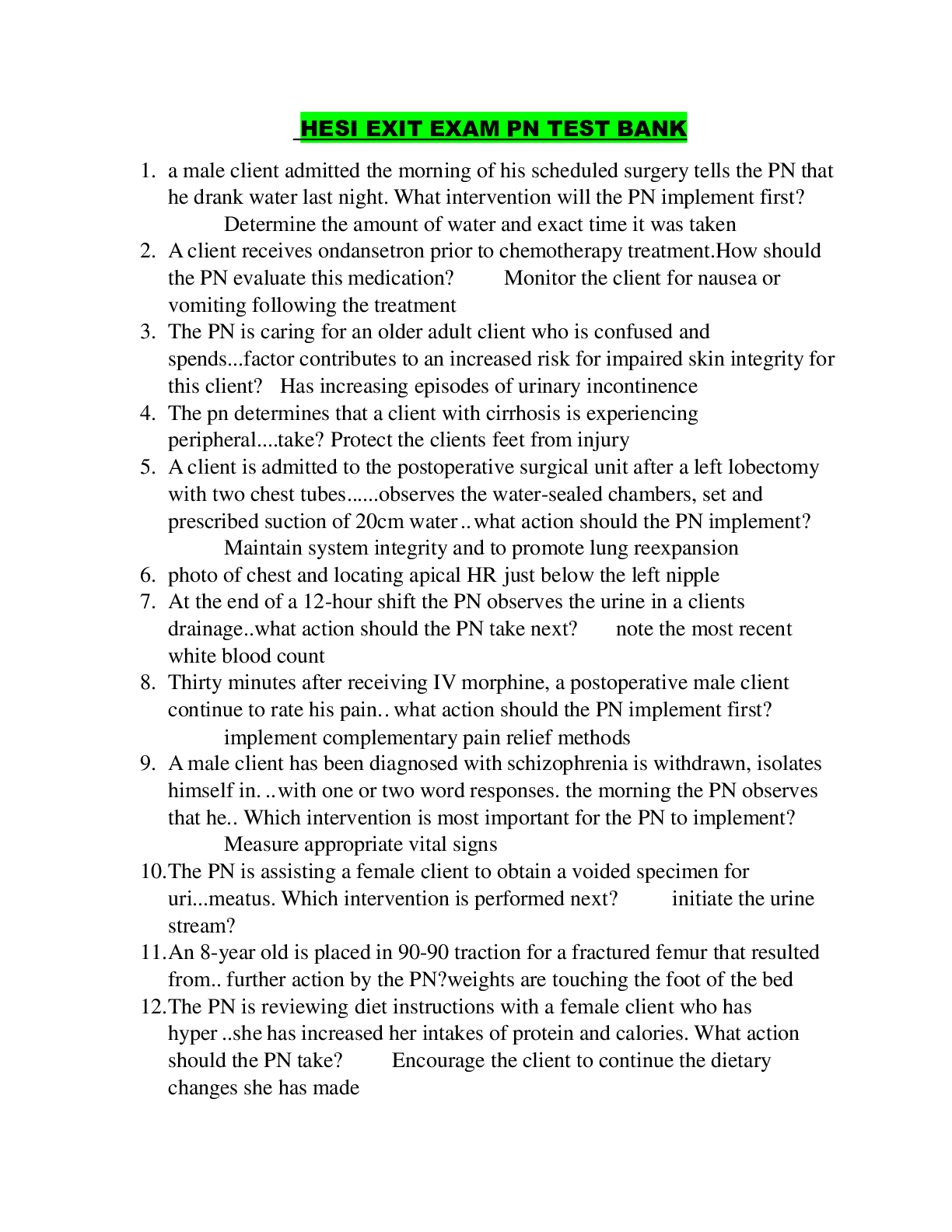
HESI PN EXIT EXAM TEST BANK 2020/2021 V1|Latest Version, Graded A+
HESI EXIT EXAM PN 2019 TEST BANK 1. A male client admitted the morning of his scheduled surgery tells the PN that he drank water last night. What intervention will the PN implement first? 2. A clie...
By Ajay25 , Uploaded: Jan 20, 2021
$13
Document information
Connected school, study & course
About the document
Uploaded On
Apr 30, 2022
Number of pages
124
Written in
Additional information
This document has been written for:
Uploaded
Apr 30, 2022
Downloads
0
Views
202






